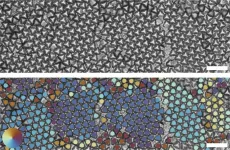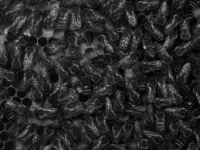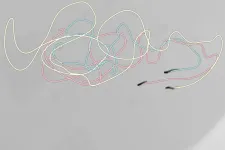(Press-News.org) In nanomaterials, shape is destiny. That is, the geometry of the particle in the material defines the physical characteristics of the resulting material.
“A crystal made of nano-ball bearings will arrange themselves differently than a crystal made of nano-dice and these arrangements will produce very different physical properties,” said Wendy Gu, an assistant professor of mechanical engineering at Stanford University, introducing her latest paper which appears in the journal Nature Communications. “We’ve used a 3D nanoprinting technique to produce one of the most promising shapes known – Archimedean truncated tetrahedrons. They are micron-scale tetrahedrons with the tips lopped off.”
In the paper, Gu and her co-authors describe how they nanoprinted tens of thousands of these challenging nanoparticles, stirred them into a solution, and then watched as they self-assembled into various promising crystal structures. More critically, these materials can shift between states in minutes simply by rearranging the particles into new geometric patterns.
This ability to change “phases,” as materials engineers refer to the shapeshifting quality, is similar to the atomic rearrangement that turns iron into tempered steel, or in materials that allow computers to store terabytes of valuable data in digital form.
“If we can learn to control these phase shifts in materials made of these Archimedean truncated tetrahedrons it could lead in many promising engineering directions,” she said.
Elusive prey
Archimedean truncated tetrahedrons (ATTs) have long been theorized to be among the most desirable of geometries for producing materials that can easily change phase, but until recently were challenging to fabricate – predicted in computer simulations yet difficult to reproduce in the real world.
Gu is quick to point out that her team is not the first to produce nanoscale Archimedean truncated tetrahedrons in quantity, but they are among the first, if not the first, to use 3D nanoprinting to do it.
“With 3D nanoprinting, we can make almost any shape we want. We can control the particle shape very carefully,” Gu explained. “This particular shape has been predicted by simulations to form very interesting structures. When you can pack them together in various ways they produce valuable physical properties.”
ATTs form at least two highly desirable geometric structures. The first is a hexagonal pattern in which the tetrahedrons rest flat on the substrate with their truncated tips pointing upward like a nanoscale mountain range. The second is perhaps even more promising, Gu said. It is a crystalline quasi-diamond structure in which the tetrahedrons alternate in upward- and downward-facing orientations, like eggs resting in an egg carton. The diamond arrangement is considered a “Holy Grail” in the photonics community and could lead in many new and interesting scientific directions.
Most importantly, however, when properly engineered, future materials made of 3D printed particles can be rearranged rapidly, switching easily back and forth between phases with the application of a magnetic field, electric current, heat, or other engineering method.
Gu said she can imagine coatings for solar panels that change throughout the day to maximize energy efficiency, new-age hydrophobic films for airplane wings and windows that mean they never fog or ice up, or new types of computer memory. The list goes on and on.
“Right now, we’re working on making these particles magnetic to control how they behave,” Gu said of her latest research already underway using Archimedean truncated tetrahedron nanoparticles in new ways. “The possibilities are only beginning to be explored.”
Additional co-authors of the work are PhD students David Doan and John Kulikowski. Gu is also a member of Stanford Bio-X.
This work was funded by the National Science Foundation, a Stanford Graduate Fellowship. DD, JK, the Hellman Foundation, and the National Science Foundation. Part of this work was performed at the Stanford Nano Shared Facilities, which is supported by the National Science Foundation, and at the Stanford Cell Sciences Imaging Facility.
END
Elusive 3D printed nanoparticles could lead to new shapeshifting materials
Stanford materials engineers have 3D printed tens of thousands of hard-to-manufacture nanoparticles long predicted to yield promising new materials that change form in an instant
2024-03-25
ELSE PRESS RELEASES FROM THIS DATE:
Bees use antennae to decode hive mates’ dances in the dark
2024-03-25
Scientists have discovered how honeybees can decipher dances by their hive mates that relay directions to food.
The findings reveal how, in the complete darkness of the hive, each bee uses its antennae to help interpret the information communicated through the dances.
It has been known for decades that honeybees do so-called waggle dances, in which their movements and orientation on the honeycomb signal the direction and distance to food outside the hive. However, until now, it was unclear how the bees gathered around a waggle dancer make sense of the information.
Gaining greater insights into how bees communicate could help scientists to better understand the effects of ...
Nucleus Genomics launches to bring whole-genome sequencing to the public
2024-03-25
Nucleus Genomics, the next-generation genetic testing and analysis company, today announced the launch of its DNA analysis product to bring the benefits of personalized medicine to everyone.
DNA and health are inextricably linked, but profound insights into how DNA can shape health are missing from healthcare. Customers who’ve previously done microarray genetic testing with older testing companies can upload their DNA data onto Nucleus’ platform to receive greater insights into their genetic risk for diseases like type 2 diabetes, breast cancer, and many more. Nucleus further personalizes these risk assessments by integrating personal ...
How many fish constitute a school?
2024-03-25
Physicists are also interested in fish – above all when they are researching the formation of structures. A research team from Heinrich Heine University Düsseldorf (HHU) and the University of Bristol (United Kingdom) has examined the schooling behaviour of zebra danio (Danio rerio, also known as “zebrafish”) using methods from the field of multi-particle physics. In the scientific journal Nature Communications, they explain that groups of just three fish already move in a similar way to large schools while, by contrast, two fish display completely ...
Provision of medications for self-managed abortion before and after the Dobbs v Jackson Women’s Health Organization decision
2024-03-25
About The Study: Provision of medications for self-managed abortions increased in the six months following the Dobbs v Jackson Women’s Health Organization decision. Results suggest that a substantial number of abortion seekers accessed services despite the implementation of state-level bans and restrictions.
Authors: Abigail R. A. Aiken, Ph.D., of the University of Texas at Austin, is the corresponding author.
To access the embargoed study: Visit our For The Media website at this link https://media.jamanetwork.com/
(doi:10.1001/jama.2024.4266)
Editor’s Note: Please see the article for additional information, ...
Common household chemicals pose new threat to brain health
2024-03-25
CLEVELAND—A team of researchers from the Case Western Reserve University School of Medicine has provided fresh insight into the dangers some common household chemicals pose to brain health. They suggest that chemicals found in a wide range of items, from furniture to hair products, may be linked to neurological diseases like multiple sclerosis and autism spectrum disorders.
Neurological problems impact millions of people, but only a fraction of cases can be attributed to genetics alone, indicating that unknown environmental factors are important contributors to neurological disease.
The new study ...
Unlocking quantum computing power: automated protocol design for quantum advantage
2024-03-25
Imagine a world where complex calculations that currently take months for our best supercomputers to crack could be performed in a matter of minutes. Quantum computing is revolutionizing our digital world. In a research article published Feb. 19 in Intelligent Computing, researchers unveiled an automated protocol-design approach that could unlock the computational power of quantum devices sooner than we imagined.
Quantum computational advantage represents a critical milestone in the development of quantum technologies. It signifies the ability of quantum computers to outperform classical supercomputers in certain tasks. Achieving ...
Pitt receives NIH grants to study health effects of chemical exposures following the East Palestine train derailment
2024-03-25
PITTSBURGH – The University of Pittsburgh has received a pair of two-year grants from the National Institutes of Health to support studies on the health effects of environmental contamination resulting from the train derailment that spilled hazardous materials into the local communities in East Palestine, Ohio, in February 2023.
The grants, totaling nearly $1 million, were awarded through a National Institute of Environmental Health Sciences ...
Researchers Discover Evolutionary “Tipping Point” in Fungi
2024-03-25
Scientists have found a “tipping point” in the evolution of fungi that throttles their growth and sculpts their shapes. The findings, published in the journal Cell Reports, demonstrate how small changes in environmental factors can lead to huge changes in evolutionary outcomes.
Fungi are nature’s great composters. They wait within the forest floor to feed on fallen trees and autumn leaves, releasing essential nutrients from these plants back into the Earth.
Although fungi often ...
Differences in donor heart acceptance by race and gender of patients on the transplant waiting list
2024-03-25
About The Study: The cumulative incidence of heart offer acceptance by a transplant center team was consistently lower for Black candidates than for white candidates of the same gender and higher for women than for men in this study. These disparities persisted after adjusting for candidate-, donor-, and offer-level variables, possibly suggesting racial and gender bias in the decision-making process. Further investigation of site-level decision-making may reveal strategies for equitable donor heart acceptance.
Authors: Khadijah Breathett, M.D., M.S., of Indiana University in Indianapolis, ...
Job flexibility, job security, and mental health among working adults
2024-03-25
About The Study: In this study of 18,000 adults who were employed, greater job flexibility was significantly associated with reduced odds of experiencing serious psychological distress and experiencing anxiety. Greater job security was significantly associated with reduced odds of experiencing serious psychological distress and experiencing anxiety.
Authors: Monica L. Wang, Sc.D., M.S., of the Boston University School of Public Health, is the corresponding author.
To access ...
LAST 30 PRESS RELEASES:
Numbers in our sights affect how we perceive space
SIMJ announces global collaborative book project in commemoration of its 75th anniversary
Air pollution exposure and birth weight
Obstructive sleep apnea risk and mental health conditions among older adults
How talking slows eye movements behind the wheel
The Ceramic Society of Japan’s Oxoate Ceramics Research Association launches new international book project
Heart-brain connection: international study reveals the role of the vagus nerve in keeping the heart young
Researchers identify Rb1 as a predictive biomarker for a new therapeutic strategy in some breast cancers
Survey reveals ethical gaps slowing AI adoption in pediatric surgery
Stimulant ADHD medications work differently than thought
AI overestimates how smart people are, according to HSE economists
HSE researchers create genome-wide map of quadruplexes
Scientists boost cell "powerhouses" to burn more calories
Automatic label checking: The missing step in making reliable medical AI
Low daily alcohol intake linked to 50% heightened mouth cancer risk in India
American Meteorological Society announces Rick Spinrad as 2026 President-Elect
Biomass-based carbon capture spotlighted in newly released global climate webinar recording
Illuminating invisible nano pollutants: advanced bioimaging tracks the full journey of emerging nanoscale contaminants in living systems
How does age affect recovery from spinal cord injury?
Novel AI tool offers prognosis for patients with head and neck cancer
Fathers’ microplastic exposure tied to their children’s metabolic problems
Research validates laboratory model for studying high-grade serous ovarian cancer
SIR 2026 delivers transformative breakthroughs in minimally invasive medicine to improve patient care
Stem Cell Reports most downloaded papers of 2025 highlight the breadth and impact of stem cell research
Oxford-led study estimates NHS spends around 3% of its primary and secondary care budget on the health impacts of heat and cold in England
A researcher’s long quest leads to a smart composite breakthrough
Urban wild bees act as “microbial sensors” of city health.
New study finds where you live affects recovery after a hip fracture
Forecasting the impact of fully automated vehicle adoption on US road traffic injuries
Alcohol-related hospitalizations from 2016 to 2022
[Press-News.org] Elusive 3D printed nanoparticles could lead to new shapeshifting materialsStanford materials engineers have 3D printed tens of thousands of hard-to-manufacture nanoparticles long predicted to yield promising new materials that change form in an instant







